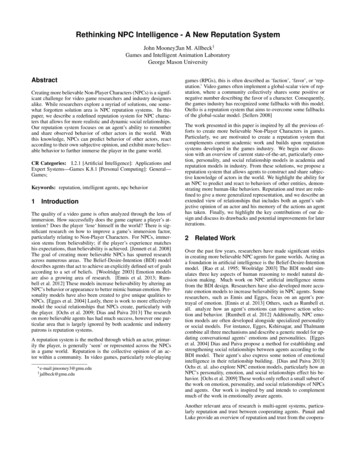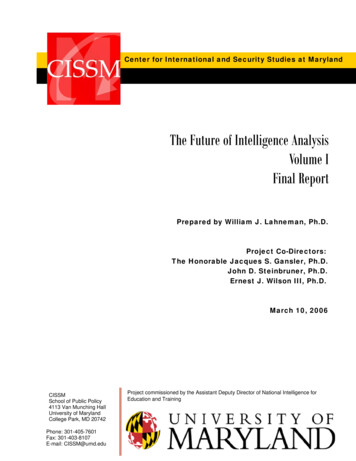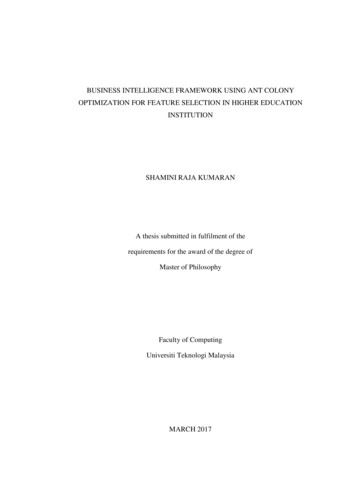
Transcription
Rethinking NPC Intelligence - A New Reputation SystemJohn Mooney ,Jan M. Allbeck†Games and Intelligent Animation LaboratoryGeorge Mason UniversityAbstractCreating more believable Non-Player Characters (NPCs) is a significant challenge for video game researchers and industry designersalike. While researchers explore a myriad of solutions, one somewhat forgotten solution area is NPC reputation systems. In thispaper, we describe a redefined reputation system for NPC characters that allows for more realistic and dynamic social relationships.Our reputation system focuses on an agent’s ability to rememberand share observed behavior of other actors in the world. Withthis knowledge, NPCs can predict behavior of other actors, reactaccording to their own subjective opinion, and exhibit more believable behavior to further immerse the player in the game world.CR Categories: I.2.1 [Artificial Intelligence]: Applications andExpert Systems—Games K.8.1 [Personal Computing]: General—Games;Keywords: reputation, intelligent agents, npc behavior1IntroductionThe quality of a video game is often analyzed through the lens ofimmersion. How successfully does the game capture a player’s attention? Does the player ‘lose‘ himself in the world? There is significant research on how to improve a game’s immersion factor,particularly relating to Non-Player Characters. For NPCs, immersion stems from believability; if the player’s experience matcheshis expectations, than believability is achieved. [Jennett et al. 2008]The goal of creating more believable NPCs has spurred researchacross numerous areas. The Belief-Desire-Intention (BDI) modeldescribes agents that act to achieve an explicitly defined set of goalsaccording to a set of beliefs. [Woolridge 2003] Emotion modelsare also a growing area of research. [Ennis et al. 2013; Rumbell et al. 2012] These models increase believability by altering anNPC’s behavior or appearance to better mimic human emotion. Personality models have also been created to give unique qualities toNPCs. [Egges et al. 2004] Lastly, there is work to more effectivelymodel the social relationships that NPCs create, particularly withthe player. [Ochs et al. 2009; Dias and Paiva 2013] The researchon more believable agents has had much success, however one particular area that is largely ignored by both academic and industrypatrons is reputation systems.A reputation system is the method through which an actor, primarily the player, is generally ‘seen’ or represented across the NPCsin a game world. Reputation is the collective opinion of an actor within a community. In video games, particularly role-playing e-mail:jmooney3@gmu.edu† jallbeck@gmu.edugames (RPGs), this is often described as ‘faction’, ‘favor’, or ‘reputation.’ Video games often implement a global-scalar view of reputation, where a community collectively shares some positive ornegative number describing the favor of a character. Consequently,the games industry has recognized some fallbacks with this model.Otello is a reputation system that aims to overcome some fallbacksof the global-scalar model. [Sellers 2008]The work presented in this paper is inspired by all the previous efforts to create more believable Non-Player Characters in games.Particularly, we are motivated to create a reputation system thatcomplements current academic work and builds upon reputationsystems developed in the games industry. We begin our discussion with an overview of current state-of-the-art, particularly emotion, personality, and social relationship models in academia andreputation models in industry. From these solutions, we propose areputation system that allows agents to construct and share subjective knowledge of actors in the world. We highlight the ability foran NPC to predict and react to behaviors of other entities, demonstrating more human-like behaviors. Reputation and trust are redefined to give a more generalized representation, and we describe anextended view of relationships that includes both an agent’s subjective opinion of an actor and his memory of the actions an agenthas taken. Finally, we highlight the key contributions of our design and discuss its drawbacks and potential improvements for lateriterations.2Related WorkOver the past few years, researchers have made significant stridesin creating more believable NPC agents for game worlds. Acting asa foundation in artificial intelligence is the Belief-Desire-Intentionmodel. [Rao et al. 1995; Woolridge 2003] The BDI model simulates three key aspects of human reasoning to model natural decision making. Much work on NPC artificial intelligence stemsfrom the BDI design. Researchers have also developed more accurate emotion models to increase believability in NPC agents. Someresearchers, such as Ennis and Egges, focus on an agent’s portrayal of emotion. [Ennis et al. 2013] Others, such as Rumbell et.all. analyze how an agent’s emotions can improve action selection and behavior. [Rumbell et al. 2012] Additionally, NPC emotion models are often developed alongside specialized personalityor social models. For instance, Egges, Kshirsagar, and Thalmanncombine all three mechanisms and describe a generic model for updating conversational agents’ emotions and personalities. [Eggeset al. 2004] Dias and Paiva propose a method for establishing andstrengthening social relationships between agents according to theBDI model. Their agent’s also express some notion of emotionalintelligence in their relationship building. [Dias and Paiva 2013]Ochs et. al. also explore NPC emotion models, particularly how anNPC’s personality, emotion, and social relationships effect his behavior. [Ochs et al. 2009] These works only reflect a small subset ofthe work on emotion, personality, and social relationships of NPCsand agents. Our work is inspired by and intends to complementmuch of the work in emotionally aware agents.Another relevant area of research is multi-agent systems, particularly reputation and trust between cooperating agents. Panait andLuke provide an overview of reputation and trust from the coopera-
tive multi-agent perspective. [Panait and Luke 2005] They highlightthe importance of reputation and trust in multi-agent systems, particularly in overcoming many challenges across a broad spectrumof applications. Panait identifies a focus on challenges of securityand optimization for these systems; two challenges which do nothold significant merit when developing an NPC reputation system.Similarly to Panait and Luke, Pinyol and Sabater-Mir give a review of reputation and trust models for multiagent systems. [Pinyoland Sabater-Mir 2013] Despite describing more recent trends in themulti-agent systems community, much of the work is still specificto security and robotics domains. Despite differences between thecommunities, our reputation system is able to draw from researchin the multi-agent systems community. For our work, we are motivated by high-level solution designs, particularly machine learningapproaches, that are overviewed within Pinait and Pinyols’ works.Lastly, our work is largely motivated by state-of-the-art reputationsystems found in the industry. Reputation systems are very common among role playing games. A player usually develops hisreputation across various communities of the game world, and often his reputation will affect gameplay mechanics. For instance,a player with high reputation may unlock more items or questswithin a specific community, or a player with large negative favor may be attacked on sight. The industry generally representsreputation according to the single-value design. That is a community of NPCs all share the same ‘likeness’ value for the player. Forinstance, the massively popular game World of Warcraft by Blizzard employs this system. The player has a reputation in each townthat represents how members of that town feel about the player, either positively or negatively. Similar systems are at work withinother largely successful RPGs: Square Enix’s Final Fantasy XIVand Bethesda Softwork’s The Elder Scrolls V: Skyrim [BlizzardEntertainment 2004; SquareEnix 2013; BethesdaSoftworks 2011] Thelimitations of the single-value system has motivated our work in thispaper. Michael Sellers of Online Alchemy also recognizes some ofthe issues with the single-scalar representation. [Sellers 2008] TheOtello system recognizes the importance of bias between participants in the community; each individual must form his own opinion. The system constructs a social graph to disseminate information between participants, and users can place differing values oftrust in those around them. While Otello does improve upon thesingle-value system of modern industry games, information is stilldisseminated immediately and without physical bias. Reputationis still limited to be either a positive or negative value. These aremotivations to create a system with a more general definition ofreputation and trust.3Redefining Reputationparticular player has a history of illegal behavior, and has shown nomercy to those who threaten his laissez-faire lifestyle. In a singlevalue system, the shopkeeper will know only to dislike the player.He may choose to avoid or express his discontentment, getting himself killed in the process. In our system, the shopkeeper has a memory of the player’s nefarious past, and he can use this informationto make more educated decisions. He understands that the player islikely to kill him if confronted negatively, however the shopkeepermay also take advantage of the player’s particular strengths to solvesome other problems. While the shopkeeper may despise the playerfor stealing his wares, he may also have high trust in the player’sability to kill the bandits that have been harassing his family. Theresult is a personal bounty-hunting quest for the player. Our definitions of reputation and trust allow for a broader view that moreaccurately resembles real human reasoning. They allow us to capture complex social situations that were previously unrepresentedin reputation systems.An overview of our agent architecture design is shown in Figure1. The components in green represent core reputation functionalityand will be the focus for the remainder of this paper. The components in green act to predict a participating agent’s next actionsgiven a memory of previous behavior, and the best-guess actions arepassed along to the planner to determine an appropriate response.4Information RepresentationAll reputation-based information in our game world is representedas an Resource Description Framework (RDF) [Tauberer 2006]triple and confidence value pair. We call this tuple a percept.The RDF triple component represents relationships between entities within the world; it can be viewed as a string containing a subject actor, relationship or action verb, and direct object. “The Playerstole from The Shopkeeper” is a simple example. Here, ‘the player’is the subject, ‘stole from’ is the predicate or relationship, and ‘theshopkeeper’ is the direct object. Attached to this RDF triple is aconfidence value between 0 and 1 that represents how much trustthe agent has in the truthfulness of this information. (“The Player stole from The Shopkeeper”, .8)An NPC gathers percepts from his environment through his perception system. Whenever an action is performed within the world, acorresponding percept is created to encode such information. A visual percept is ‘seen’ when it enters the unoccluded view frustumof an NPC within the world, and an audial percept is ‘heard’ whenan NPC moves within some proximity of the information. Figure2 displays a graphical representation of a visual and audial perceptrespectively.In improving upon the industry standard, we have identified threekey contributions of a reinvented reputation system. A reputationsystem should:1. Allow for realistic information sharing between agents2. Represent the subjective opinions of community members3. Incorporate a broader definition of reputation and trustWe first give our definition of trust and reputation in accordancewith our system. An actor’s reputation is a prediction of futurebehavior or actions based on a memory of recorded actions andevents. Trust is defined as the confidence an entity holds in thetruthfulness of information.These definitions allow us to represent more rich relationships between actors within our world. For instance, consider an RPG gamewhere the player has recently stolen from the local shopkeeper. ThisFigure 2: Graphical Representation of Percepts - Left: Two boxesrepresent visible percepts - Right: A sphere represents an audiblepercept4.1Retrieving InformationThe trust value associated with each percept is a necessary condition in the case of gossip. Any raw percept, that is any perceptdirectly created by the environment, is received with 100% confidence. NPCs have the ability to share percepts with one another,
Figure 1: NPC Architectureand when this occurs, a listening NPC reduces his trust in this information accordingly. As in Otello, this is used to prevent infinitedissemination of information, provides bias between agents, andprovides an easy mechanism for resolving conflicting information;if one NPC has low trust in the truthfulness of another NPC, hemay dramatically lower the trust of any received percepts from thatsource. As information passes from agent to agent, the truthfulnessof an information steadily decreases until it is fundamentally 0 andis no longer relevant.Using this scheme, we are able to represent communication between agents, a key component of our redesigned reputation system. When two agents wish to communicate, they share information via percepts in their environment. We have created a medievaltown resembling Bethesda Softworks’ The Elder Scrolls Skyrim,RPG. The characters in our world do not live with the luxury of thecell phone, so they must speak with one another directly to sharetheir gossip. When two NPCs meet to talk about the town, theyshare percepts with one another by creating communication-audialpercept zones, which are specially marked to distinguish from environmental percepts. This creates an important distinction fromthe single-value reputation systems of Skyrim or the social graphsystem of Otello because for an NPC to receive information aboutthe player, he must witness it directly or overhear it from gossipwithin the town. If a witnessing agent is unable or chooses notto share his information with the members of the town, then theplayer’s reputation will not be affected. Additionally, an NPC maychoose with whom the information is shared, so one could anticipate cliques forming within the social space of the town distinguishing one group of trusted NPCs from another. This schemeallows our reputation system to model realistic information sharingbetween agents.4.2Understanding Information - The OntologyIn order for the NPCs to understand what actions are being performed within the world, we have designed an ontology that establishes relationships between different actions. The ontology categorizes actions and RDF predicates into groups, where each groupshares some similarities. For instance, the action ‘attack’ is categorized under (‘Action’, ‘Directed’, ‘Physical’, ‘Harmful.’) Theaction ‘kill’ is categorized the same, while the action ‘talk’ is (‘Action’, ‘Directed’, ‘Social.’) This representation allows our NPCs todraw extended conclusions about percepts they receive and is described in further detail in section 5.1.3.It is important to note that our action ontology is still a work inprogress. In our current implementation, the ontology is defined byhand according to our intuitions. We recognize the need for furtherresearch into this area, particularly in drawing from natural language resources to better understand relationships between actions.While not the target of this paper, we look toward to future work inthis area. A promising avenue we may explore includes automaticontology generation [Alani et al. 2003].4.3Storing Information - Memory ModelsAn integral component to any human-like agent system is a realistic memory model. For our reputation system, the memory modelplays a key role in forwarding relevant information to the prediction module as well as limiting the complexity of perceptual information. As an agent senses his environment, percepts are passedto the memory model before being processed by the action planner.This allows the memory system to truncate any irrelevant or repetitive percepts. Additionally, the memory system is responsible forefficiently identifying the known history of an actor and forwardingthis information to the prediction module.In our current implementation, we utilize a very simple memorythat stores an agent’s percepts as textual RDFs in a mapping structure. When stimuli is forwarded to the memory, we identify the keyactors involved in the perceived event and index to retrieve relevantinformation. At the moment, our memory model serves only as aninterface between the environment and the prediction module. Inour future work, we hope to implement a more realistic memorysystem such as [Li et al. 2013; Kope et al. 2013] to more accuratelysimulate real humans.
5The Prediction Module5.1.2Another important component of our reputation system is the prediction module. The prediction module is responsible for estimating another agent’s future actions given a subjective history of pastactions; we achieve this functionality using a Bayesian Network.Given an actor A’s history, our NPCs learn a bayesian network thatcalculates the likelihood that actor A will perform some action. After relevant probabilities have been calculated, the module forwardsa list of agent A’s most probable actions to the planning module.Data: Dictionary P - Probability of each action a in A, Integer nResult: A list of n-maximum probability actions for some actorSort(P); //According to Descending Probabilitiesfor (int i 0, i ¡ n, i ) doAdd(List L, P[i]);endreturn List L;Algorithm 1: Forwarding most probable actionsOur system utilizes a bayesian network for this method for a fewspecific reasons. Firstly, bayesian networks are capable of computing large quantities of independent probabilities efficiently. [Cozman et al. 2000]. Additionally, our problem space can be represented as a series of dependent random variables, and prior probabilities are initially zero; an agent has no prior knowledge of otheractors. Lastly, the bayesian network’s relatively simple approach tomachine learning fits our application domain perfectly. The idea isstraightforward and provides logical and consistent results for ouragents. The high-level design of the prediction module is displayedin green in Figure 1.5.1Bayesian Network DesignWhen designing our bayesian network, we identified three key features that must be taken into account: The history of actions an actor A has performed, the environment in which actor A is present,and the set of actions that A has not yet, but could at some pointact out. Each of these is discussed in greater detail below. In addition to considering these factors when evaluating agent A’s likelynext move, we have also included functionality for personality todrive the prediction process. If NPC B is predicting actor A’s nextmove, B’s personality may influence the decision he arrives at. Forinstance, if B is an optimistic person, he may believe A will actpositively on his next move when a pessimistic individual woulddisagree. This functionality has not been implemented in our system, but we are excited for this avenue of future work.5.1.1Acting EnvironmentThe acting environment is a broad definition for the environmentvariables that may have an impact on an actor’s decisions. Thisenvironment includes a vast number of possibilities such as actorA’s current emotional state, the objects at A’s current disposal, andif there are any other agents whom could skew A’s decision making. The list continues and is an interesting area of future research,but for our purposes we simplify the acting environment solely tothe direct object which is being acted upon. Referring back to ourdefinition of the percept and its RDF triple, we note that every information unit may have an associated direct object. The intuitionbehind this is that an actor may act on certain objects in some specific way that is consistent. For example, consider the case wherewe observe an actor A in a room with a broomstick. Our memory of A might suggest he goes to sleep, because that is the actionwe most frequently observe him perform. However, we also observe the broomstick and remember that whenever we see A and abroomstick nearby, A has swept the floor. The idea of the actingenvironment has countless extensions and plays a significant rolein the accuracy of our predictions. The modified equation is givenbelow.P (a Hist(A), Env(A)) 5.1.3#a 1kHist(A) Env(A)k 2(2)Action OntologyLastly, one can observe that actions are generally related to oneanother. For instance, ‘attacking’ and ‘killing’ share many similarities, and one may argue that a history of attacking may suggest asimilarly violent future. To capture this intuition, we refer to the action ontology previously described. As all actions are categorizedaccording to an explicit ontology, we can generalize the actions of acharacter to expect similar behavior. This idea proves a significantchallenge however. How does one determine how influential thesesimilarities should be? Will different NPC observers have dissenting opinions on how significant similar actions should be? For ourimplementation, we have concluded that this generalization shouldinfluence the decision, however it should not drastically change theoutcome of the expected behavior. Our solution is to strictly limitthe potency of this observation. The goal is to recognize that whenan actor has a history of attacking, but has never committed murder,the probability of murder is likely non-zero. Our equation is listedbelow and can be applied after the posterior probabilities have beenestablished. It is important to note that this equation can be appliedin O(n) efficiency using dynamic programming algorithms.Action HistoryAn actor A’s action history is the largest indicator of his/her nextintentions. This information is passed to the bayesian network directly from NPC B’s memory model, and it directly modifies theprior probabilities for each considered action. The probability thatactor A performs action a is related to the number of times A hasdone a and the total number of actions A has completed. Equation1 likely gives a more understandable definition. It should be notedthat we apply an m-estimate to avoid margin errors.P (a Hist(A)) #a 1kHist(A)k 2(1)This definition alone is enough for a simple bayesian network andprediction module. However, we can construct more educatedguesses with some additional information.P (a Similar(a, b)) 1M ax( P (b Hist(A), Env(A)), P (a Hist(A), Env(A)))5(3)In our future work, we will explore new ways of confronting thisrelationship. Particularly, we hope to focus on how actions relate toone another and how that influences human decision making.5.2Bayesian Network StructureGiven these considerations, the final task is constructing the physical structure of the bayesian network. Figure 3 shows the two-layerarchitecture of our bayes nets.
els, reputation systems have not advanced as rapidly. In this paper, we have outlined some key benefits of a redesigned reputationmodel. We describe a system that:1. Allows for realistic information sharing between agents2. Represents the subjective opinions of community membersFigure 3: A two-level prediction netThe prediction network is implemented as a two-layer bayesian network, where the acting environment variables parent the actions anactor may take. We populate the prior probability tables according to the equations listed in section 5.1. From here, we can applya variable elimination algorithm [2000] to efficiently compute theprobability that actor A performs each action, with and without anacting environment.When constructing the bayesian network, we also utilize a simplepresence hueristic to significantly reduce computation costs. Eachbayesian network begins with zero nodes, and is built up as ourNPC learns about other agents in the world. When an NPC performs an action in a certain environment, we create the corresponding nodes in the bayesian network. If the nodes already exist, weupdate the probability tables to reflect the new information. In thismanner, no unnecessary nodes will complicate the calculation. Asignificant challenge however is the efficient memory managementof these bayesian networks. We recognize the complexity of thissolution and provide a discussion in our concluding remarks.6Our design provides a unique solution to the player-shopkeeper scenario. A player enters a new town in medieval times, so his reputation is unknown among the community. After a frenzy of attackson a group of nearby merchants, the player quickly makes a namefor himself. The player’s ‘attack’ action creates visible perceptsthat some bystanders take note-of, and soon audial gossip perceptsare popping up all over town. Importantly, because each NPC’sknowledge is limited by their perception system, members of thetown come to different subjective conclusions about the player. Afew NPCs have not heard of the player’s vicious attacks, many whohave are fearful and flee, some are impressed by the players prowessand confront him with new job offers. The player’s reputation is notconstrained by a single global value, so more complex relationshipsoccur. For instance, the shopkeeper has knowledge of the player’smany attacks. He is able to predict that the player will likely attack again, and though he is fearful, the shopkeeper desires thathis business competitor be ‘taken care of’. He understands thereis high-likelihood of the player attacking successfully, so he confronts the player with a bounty for the death of his neighbor. Ofcourse, the shopkeeper and player must be careful to discuss privately. They wouldn’t want word of their nefarious deal to spreadthroughout town.Action PlanningThe action planning module is responsible for determining theNPC’s next action to perform given information about the world.For a traditional Belief-Desire-Intention system, this module analyzes the agent’s current intentions to determine his next course ofevents, but things are a bit more complicated when our reputationsystem is included. In addition to analyzing the agent’s belief, desires, and intentions, the planning module must also consider thepredicted actions of his neighbors. This extra factor challenges thealready-difficult problem of agent planning with a new consideration, and there may be situations when the next best action hasconflicting interests. Consider again the shopkeeper and the nefarious player. The shopkeeper must decide if he should confront thethief or avoid a confrontation; while the shopkeeper is aware of theplayer’s murderous reputation, he is also driven by his own desiresand intentions to maintain profits in his shop to feed his family.These conundrums are difficult for real humans, and are now moreevident when the reputation system is included.Our solution to this problem remains a work in progress. There issignificant room for improvement for more robust action plannerson NPC agents, and our current research efforts are focused on developing a synergy between an agent’s desires and the new form ofknowledge that is reputation. While not an intended contributionof this paper, we expect to provide more details regarding the action planning module of our reputation system in the near future.Our path to solving this problem lies in action planning research,particularly on the complexities of the BDI model.73. Incorporates a broader definition of reputation and trustConclusions and Future WorkCreating more believable NPCs is a significant challenge for gameresearches and designers alike. While there have been significantimprovements across emotion, personality, and relationship mod-In regard to the contributions in this paper, there remains significantroom for improvement in tackling the problem of NPC believability. For our system, our foremost concern is integrating reputationinto an agent’s planning processes. We hope for our NPCs to determine their next actions based upon a combination of their desiresas well as predicted behavior of their neighbors. Another avenue offuture work is in developing an assessment of our reputation system. It is our ultimate goal to conduct user studies, where participants highlight an increase in immersion and higher believabilityfor our NPC agents. However, we believe that the agent planningprocesses must first be finished before a user can adequately interactwith our reputation system. Our reputation system also raises questions about performance for large scale games and applications, andwhile we have provided heuristics that significantly reduce computation costs, future work will require a metric overview of thesystem’s complexity as the number of agents and actions increase.We believe our contributions in this paper highlight a relatively ignored solution area for the NPC believability problem. We describea system that rethinks how NPCs gather and share reputation information and provides new decision making tools for the creation ofbelievable Non-Player Characters.ReferencesA LANI , H., K IM , S., M ILLARD , D., W EAL , M., H ALL , W.,L EWIS , P., AND S HADBOLT, N. 2003. Automatic ontologybased knowledge extraction from web documents. IntelligentSystems, IEEE 18, 1 (Jan), 14–21.B ETHESDA S OFTWORKS, 2011. The elder scrolls v: Skyrim. [CDROM].B LIZZARD E NTERTAINMENT, 2004.ROM].World of warcraft.[CD-
C OZMAN , F. G., ET AL . 2000. Generalizing variable elimination inbayesian networks. In Workshop on Prob. Reasoning in BayesianNet
able behavior to further immerse the player in the game world. CR Categories: I.2.1 [Artificial Intelligence]: Applications and Expert Systems—Games K.8.1 [Personal Computing]: General— Games; Keywords: reputation, intelligent agents, npc behavior 1 Introduction The quality of a video game is often analyzed through the lens of immersion.










